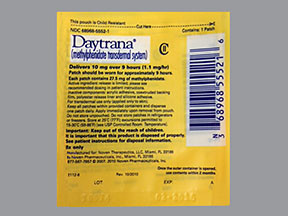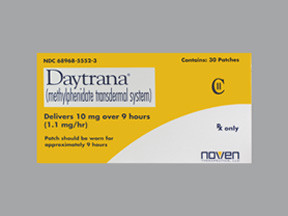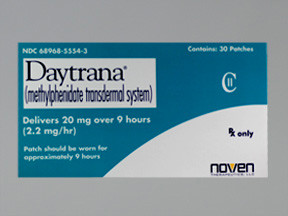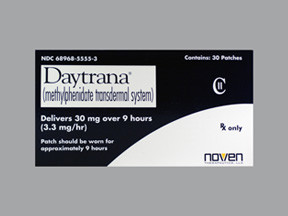METHYLPHENIDATE - TRANSDERMAL
PHONETIC PRONUNCIATION: (METH-il-FEN-i-date)
COMMON BRAND NAME(S): Daytrana
GENERIC NAME(S): methylphenidate
Uses
USES: This medication is used to treat attention deficit hyperactivity disorder - ADHD. It works by changing the amounts of certain natural substances in the brain. Methylphenidate belongs to a class of drugs known as stimulants. It can help increase your ability to pay attention, stay focused on an activity, and control behavior problems. It may also help you to organize your tasks and improve listening skills.
How to use METHYLPHENIDATE - TRANSDERMAL
HOW TO USE: Read the Medication Guide provided by your pharmacist before you start using methylphenidate and each time you get a refill. Read and follow all directions in the Patient Information Leaflet. Learn how to properly use, store, and discard the patches. If you have any questions, ask your doctor or pharmacist. Apply this medication to the skin as directed by your doctor, usually once daily in the morning, 2 hours before you need the effects of this drug. Then remove the patch as directed by your doctor, usually 9 hours later. Applying this medication late in the day may cause trouble sleeping (insomnia). If you apply this patch in the early morning and still have trouble sleeping, your doctor may direct you to remove the patch within less than 9 hours. Carefully follow your doctor's instructions. This medication should be applied to a clean, dry area of skin on the hip. Before applying the patch, gently wash, rinse, and dry the application area. Do not apply to cut or irritated skin. Remove the patch from the pouch and apply right away as directed. Do not cut the patch. When using a new patch the next day, apply to an area of skin on the other hip to avoid irritation. Do not apply a heating pad or other heat to the patch area since this may increase the risk of side effects. Bathing, swimming, or showering may affect how well the patch stays on the skin. If the patch does not stick properly or falls off, replace with a new patch at another site. Remove the new patch at your usual time, usually 9 hours after applying the first patch. After removing the patch, fold it in half with the sticky sides together and throw it away as directed. Do not touch the sticky side with your fingers. Wash your hands after applying or removing the patch. Use this medication regularly to get the most benefit from it. To help you remember, use it at the same time each day. The dosage is based on your medical condition and response to treatment. Your doctor may direct you to gradually increase or decrease your dose. Also, if you have used it for a long time, do not suddenly stop using this drug without consulting your doctor. This medication may cause withdrawal reactions, especially if it has been used regularly for a long time or in high doses. In such cases, withdrawal symptoms (such as depression, suicidal thoughts, or other mental/mood changes) may occur if you suddenly stop using this medication. To prevent withdrawal reactions, your doctor may reduce your dose gradually. Consult your doctor or pharmacist for more details, and report any withdrawal reactions right away. When used for a long time, this medication may not work as well. Talk with your doctor if this medication stops working well. Though it helps many people, this medication may sometimes cause addiction. This risk may be higher if you have a substance use disorder (such as overuse of or addiction to drugs/alcohol). Use this medication exactly as prescribed to lower the risk of addiction. Ask your doctor or pharmacist for more details. Tell your doctor if your condition does not improve or if it worsens.
Side Effects
Precautions
Interactions
Overdose
Images
Reviews
Faq for METHYLPHENIDATE - TRANSDERMAL
Methylphenidate Transdermal is a medication patch that is used to treat attention deficit hyperactivity disorder (ADHD) in children aged 6 to 17 years. It contains the active ingredient methylphenidate, which is a central nervous system stimulant.
Methylphenidate Transdermal works by increasing the levels of certain chemicals in the brain that help with impulse control and hyperactivity. The medication is absorbed through the skin and slowly released into the bloodstream throughout the day.
Common side effects of Methylphenidate Transdermal may include skin irritations or reactions at the patch application site, loss of appetite, weight loss, difficulty sleeping, headache, and increased blood pressure or heart rate. It is important to discuss any side effects with a healthcare professional.
Methylphenidate Transdermal patches are applied to clean, dry, and hairless areas of the skin. They should be pressed firmly for about 30 seconds to ensure proper adhesion. The patch should be applied to a different area of the body each day to reduce the risk of skin irritation. It is important to follow the specific instructions provided by the healthcare provider.
It is important to inform the healthcare provider about any medical conditions or allergies before using Methylphenidate Transdermal. This medication may interact with other drugs, and it is crucial to disclose all medications being taken. Methylphenidate Transdermal should not be used by individuals with a history of heart problems, high blood pressure, or glaucoma.
Methylphenidate Transdermal patches are designed to provide continuous medication release for approximately 9 hours each day. The patch should be removed in the evening to allow for a restful sleep.
Methylphenidate Transdermal patches should not be worn while swimming or bathing. However, they are designed to be water-resistant, meaning they can withstand exposure to water during activities such as showering or exercising. It is important to avoid exposing the patch to excessive moisture or heat.
The Methylphenidate Transdermal patch should not be cut or altered in any way. Doing so may affect its effectiveness and increase the risk of adverse reactions. The patch should only be used as directed by the healthcare provider.
Yes, there are alternative forms of methylphenidate available, such as oral tablets or capsules. These alternative forms may be more suitable for individuals who cannot tolerate the transdermal patch or require a different dosing schedule. It is important to consult with a healthcare provider to determine the most appropriate treatment option.
Warning
WARNING: Misuse or abuse of methylphenidate can result in serious (possibly fatal) heart and blood pressure problems. This medication can be habit-forming and should be used cautiously by people who have mental/mood disorders or a substance use disorder (such as overuse of or addiction to drugs/alcohol). Before using this medication, tell your doctor if you have a personal or family history of a substance use disorder. Do not increase your dose, use it more often, or use it for a longer time or in a different way than prescribed. Doing so may result in a decrease in the effect of this drug, drug dependence, or abnormal thoughts/behavior. Your doctor may monitor you for a while after the medication is stopped, especially if you have used this drug for a long time or in high doses. (See also How to Use section.)
Disclaimer
IMPORTANT: HOW TO USE THIS INFORMATION: This is a summary and does NOT have all possible information about this product. This information does not assure that this product is safe, effective, or appropriate for you. This information is not individual medical advice and does not substitute for the advice of your health care professional. Always ask your health care professional for complete information about this product and your specific health needs.





No Reviews Yet